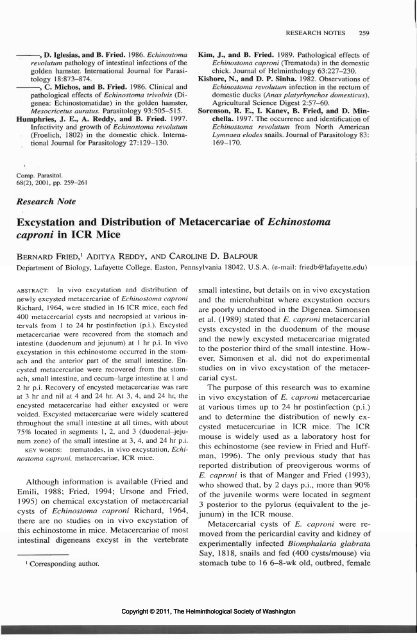Comparative Parasitology 68(2) 2001 - Peru State College
Comparative Parasitology 68(2) 2001 - Peru State College
Comparative Parasitology 68(2) 2001 - Peru State College
Create successful ePaper yourself
Turn your PDF publications into a flip-book with our unique Google optimized e-Paper software.
, D. Iglesias, and B. Fried. 1986. Echinostoma<br />
revolutum pathology of intestinal infections of the<br />
golden hamster. International Journal for <strong>Parasitology</strong><br />
18:873-874.<br />
-, C. Michos, and B. Fried. 1986. Clinical and<br />
pathological effects of Echinostoma trivolvis (Digenea:<br />
Echinostomatidae) in the golden hamster,<br />
Mesocricetus auratus. <strong>Parasitology</strong> 93:505=515.<br />
Humphries, J. E., A. Reddy, and B. Fried. 1997.<br />
Infectivity and growth of Echinostoma revolutum<br />
(Froelich, 1802) in the domestic chick. International<br />
Journal for <strong>Parasitology</strong> 27:129-130.<br />
Comp. Parasitol.<br />
<strong>68</strong>(2), <strong>2001</strong>, pp. 259-261<br />
Research Note<br />
RESEARCH NOTES 259<br />
Kim, J., and B. Fried. 1989. Pathological effects of<br />
Echinostoma caproni (Trematoda) in the domestic<br />
chick. Journal of Helminthology 63:227-230.<br />
Kishore, N., and D. P. Sinha. 1982. Observations of<br />
Echinostoma revolutum infection in the rectum of<br />
domestic ducks (Anas platyrhynchos domesticiis).<br />
Agricultural Science Digest 2:57-60.<br />
Sorenson, R. E., I. Kanev, B. Fried, and D. Minchella.<br />
1997. The occurrence and identification of<br />
Echinostoma revolutum from North American<br />
Lymnaea elodes snails. Journal of <strong>Parasitology</strong> 83:<br />
169-170.<br />
Excystation and Distribution of Metacercariae of Echinostoma<br />
caproni in ICR Mice<br />
BERNARD FRIED,' ADITYA REDDY, AND CAROLINE D. BALFOUR<br />
Department of Biology, Lafayette <strong>College</strong>, Easton, Pennsylvania 18042, U.S.A. (e-mail: friedb@lafayette.edu)<br />
ABSTRACT: In vivo excystation and distribution of<br />
newly excysted metacercariae of Echinostoma caproni<br />
Richard, 1964, were studied in 16 ICR mice, each fed<br />
400 metacercarial cysts and necropsied at various intervals<br />
from 1 to 24 hr postinfection (p.i.). Excysted<br />
metacercariae were recovered from the stomach and<br />
intestine (duodenum and jejunum) at 1 hr p.i. In vivo<br />
excystation in this echinostome occurred in the stomach<br />
and the anterior part of the small intestine. Encysted<br />
metacercariae were recovered from the stomach,<br />
small intestine, and cecum-large intestine at 1 and<br />
2 hr p.i. Recovery of encysted metacercariae was rare<br />
at 3 hr and nil at 4 and 24 hr. At 3, 4, and 24 hr, the<br />
encysted metacercariae had either excysted or were<br />
voided. Excysted metacercariae were widely scattered<br />
throughout the small intestine at all times, with about<br />
75% located in segments 1, 2, and 3 (duodenal-jejunum<br />
zone) of the small intestine at 3, 4, and 24 hr p.i.<br />
KEY WORDS: trematodes, in vivo excystation, Echinostoma<br />
caproni, metacercariae, ICR mice.<br />
Although information is available (Fried and<br />
Emili, 1988; Fried, 1994; Ursone and Fried,<br />
1995) on chemical excystation of metacercarial<br />
cysts of Echinostoma caproni Richard, 1964,<br />
there are no studies on in vivo excystation of<br />
this echinostome in mice. Metacercariae of most<br />
intestinal digeneans excyst in the vertebrate<br />
Corresponding author.<br />
small intestine, but details on in vivo excystation<br />
and the microhabitat where excystation occurs<br />
are poorly understood in the Digenea. Simonsen<br />
et al. (1989) stated that E. caproni metacercarial<br />
cysts excysted in the duodenum of the mouse<br />
and the newly excysted metacercariae migrated<br />
to the posterior third of the small intestine. However,<br />
Simonsen et al. did not do experimental<br />
studies on in vivo excystation of the metacercarial<br />
cyst.<br />
The purpose of this research was to examine<br />
in vivo excystation of E. caproni metacercariae<br />
at various times up to 24 hr postinfection (p.i.)<br />
and to determine the distribution of newly excysted<br />
metacercariae in ICR mice. The ICR<br />
mouse is widely used as a laboratory host for<br />
this echinostome (see review in Fried and Huffman,<br />
1996). The only previous study that has<br />
reported distribution of preovigerous worms of<br />
E. caproni is that of Manger and Fried (1993),<br />
who showed that, by 2 days p.i., more than 90%<br />
of the juvenile worms were located in segment<br />
3 posterior to the pylorus (equivalent to the jejunum)<br />
in the ICR mouse.<br />
Metacercarial cysts of E. caproni were removed<br />
from the pericardial cavity and kidney of<br />
experimentally infected Biomphalaria glabrata<br />
Say, 1818, snails and fed (400 cysts/mouse) via<br />
stomach tube to 16 6-8-wk old, outbred, female<br />
Copyright © 2011, The Helminthological Society of Washington
















